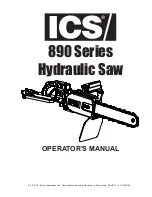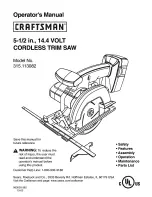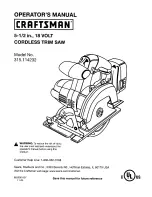
13
E N G L I S H •
User's Manual
pervised or trained to operate the product by
a person responsible for their safety. Children
should be supervised to ensure they do not use
the devices as toys.
TOOL USE AND CARE
Do not force the power tool. Use the correct
tool for the application. The correct tool will do
the job better and more safely at the rate that it
was designed to work at.
Do not use tools if switch does not turn it on or
off. Any tool that cannot be controlled with the
switch is dangerous and must be repaired.
Disconnect the plug from the power source be-
fore making any adjustments, changing acces-
sories or storing the tool. This preventive safety
measures reduce the risk of accidental starting
of the tool.
When the power tool is not in use, store it out
of the reach of children, and do not allow in-
dividuals who are not familiar with the power
tool or these instructions to operate it. Power
tools are dangerous in the hands on untrained
users.
Maintain the power tool. Check for misalign-
ment or binding of moving parts, broken parts,
and any other condition that may affect the
operation of the power tool. If it is damaged,
have it repaired before using. Many accidents
are caused by poorly maintained power tools.
Check for misalignment or bonding of moving
parts, breakage parts, and any other condition
that may affect the tools operation. If you find
a damaged tool, take it to service before use it.
Use only accessories that are recommended by
the manufacturer of your model. Suitable ac-
cessories for one tool, may become hazardous
when are used on another tool.
Keep cutting tools, sharpened and clean. Cut-
ting tools in good condition with sharpened
edges, are less likely to stuck in workpieces or
easier to control.
Is recommendable to use a safety device suit-
able, such a thermal and differential switch
when you are using an electric equipment.
SERVICE
Tool service must be performed only by quali-
fied repair personnel. Service or maintenance
performed by unqualified personnel could re-
sult in a risk of injury.
SPECIFIC SAFETY RULES FOR
CIRCULAR SAWS
DANGER: Keep hands away from cutting
area and blade. Keep your second hand on the
auxiliary handle or motor housing.
Do not position your body in direct line with
the saw blade. Position your body to either side
of the saw blade. Kickback could cause the saw
to jump backwards.
DO NOT reach underneath the work. The guard
cannot protect you from the portion of the
blade that is beneath the workpiece.
DANGER: When sawing through a work-
piece, the lower blade guard does not cover
the blade on the underside of the workpiece.
Always keep your hands and fingers away from
the cutting area.
Check the lower guard for proper closing before
each use. Do not operate the saw if the lower
guard does not move freely and close instantly.
Never clamp or tie the lower guard in the open
position. If the saw is accidentally dropped, the
lower guard may be bent. Raise the lower guard
with the retracting lever; the guard is operating
properly when it moves freely, does not touch
the blade or any other part in all angles and
depths of cut, and readily returns to the closed
position.
Check the operation and condition of the lower
guard spring. If the guard and the spring are
not operating properly, they must be serviced
before use. The lower guard may operate slug-
gishly due to damaged parts, gummy deposits,
or a buildup of debris. Do not operate your saw
until the damaged part has been repaired or re-
placed.
The lower guard should be retracted manually
only for making special cuts, such as pocket or
compound cuts. Always raise the lower guard by
retracting its lever. As soon as the blade enters
the material, the lower guard must be released.
For all other sawing, the lower guard should be
allowed to operate automatically.
Always make sure that the lower guard is cov-
ering the blade before placing the saw on a
workbench or floor. Make note of the time it
takes for the blade to stop spinning after the
switch is released. An unprotected moving
blade will cause the saw to travel backwards,
cutting whatever is in its path.
Never hold the piece being cut in your hands
or across your legs. It is important to support
the workpiece properly in order to minimize body
exposure, blade binding, or loss of control.
Hold tool by insulated gripping surfaces (han-
dles) when performing an operation where the






































